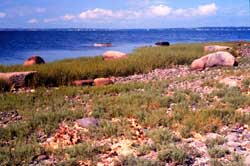You are here: Home › Stressors › Hypoxia & Nutrient Pollution › Assessment of Ecosystem Responses to Nitrogen Load Reductions Could Inform the Development of a Forecast Model for Mitigating Hypoxia in Narragansett Bay, Rhode Island
Assessment of Ecosystem Responses to Nitrogen Load Reductions Could Inform the Development of a Forecast Model for Mitigating Hypoxia in Narragansett Bay, Rhode Island
 National Centers for Coastal Ocean Science (NCCOS)-sponsored scientists
from the University of Rhode Island, Brown University, University
of Connecticut, Virginia Institute of Marine Science, and Narragansett
Bay Estuary Program are working closely with state managers to assess
the ecosystem responses to nitrogen load reductions and to develop
a forecast model as a critical adaptive management tool for mitigating
hypoxia. In 2003, an intensive hypoxia event in Narragansett Bay resulted
in a large fish kill, prompting a new state law to impose nitrogen
limits on wastewater treatment facilities that are the dominant source
of nutrient loads to the Bay. This summer, data from a combination
of large-scale spatial conductivity, temperature and depth (CTD) surveys,
moored vertical profilers, and high-resolution towed undulator surveys
have revealed a hypoxic zone as large as the extreme 2003 event, extending
throughout most of the Bay's northern region and covering most of the
lower water column on neap tides. Information on this hypoxic event
and the project's plans to improve management capabilities will be
presented at the first annual “Workshop on
Hypoxia in Narragansett Bay” on October 2, 2006 that will include representatives
from the National Oceanic & Atmospheric Administration, Environmental Protection
Agency, and nine state agencies. For more information, please contact Alan
Lewitus at Alan.Lewitus@noaa.gov,
or Larry Pugh at Larry.Pugh@noaa.gov.
National Centers for Coastal Ocean Science (NCCOS)-sponsored scientists
from the University of Rhode Island, Brown University, University
of Connecticut, Virginia Institute of Marine Science, and Narragansett
Bay Estuary Program are working closely with state managers to assess
the ecosystem responses to nitrogen load reductions and to develop
a forecast model as a critical adaptive management tool for mitigating
hypoxia. In 2003, an intensive hypoxia event in Narragansett Bay resulted
in a large fish kill, prompting a new state law to impose nitrogen
limits on wastewater treatment facilities that are the dominant source
of nutrient loads to the Bay. This summer, data from a combination
of large-scale spatial conductivity, temperature and depth (CTD) surveys,
moored vertical profilers, and high-resolution towed undulator surveys
have revealed a hypoxic zone as large as the extreme 2003 event, extending
throughout most of the Bay's northern region and covering most of the
lower water column on neap tides. Information on this hypoxic event
and the project's plans to improve management capabilities will be
presented at the first annual “Workshop on
Hypoxia in Narragansett Bay” on October 2, 2006 that will include representatives
from the National Oceanic & Atmospheric Administration, Environmental Protection
Agency, and nine state agencies. For more information, please contact Alan
Lewitus at Alan.Lewitus@noaa.gov,
or Larry Pugh at Larry.Pugh@noaa.gov.

